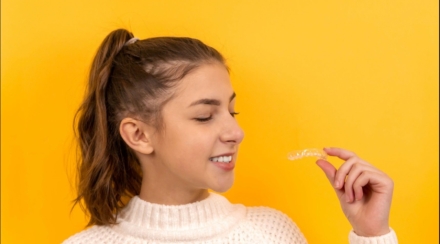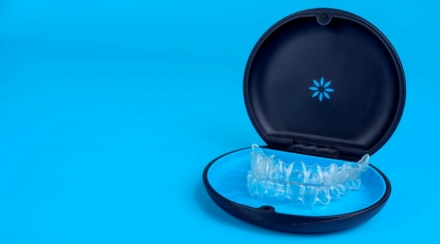Parents are sometimes anxious about their child’s digit sucking habit and will seek advice from their health professional. Digit sucking is a natural reflex for a baby that may begin whilst in-utero, and parents should be assured that a sucking habit is considered to be a normal feature of a young child’s development.
It is however well documented that if the habit continues past the age of 5 to 6 years into the mixed and permanent dentition, there is the potential for undesirable tooth movement and malocclusions may develop1-3.
How common are these habits?
Reviews of the literature show a large variation in the incidence of digit sucking according to population and age. It is reported that while up to 50% of children may have had a sucking habit in infancy, by the age of 12 years the habit may remain in as few as 2% of the population1,3,4. Surprisingly, a 1991 study of children in Dunedin reported more than 11% of that population were still sucking their digits to some extent at 11 years of age5.
In comparison, the incidence of dummy sucking has generally been reported to be around 20 to 35% in infants, however this appears to have greatly increased in the western world in recent times, with a corresponding reduction in digit sucking1,4,6. Good news for parents is that dummy sucking rarely leads to a digit sucking habit, and is generally ceased by the age of 3 years1,6.
In most cases digit sucking appears to be a learned habit, with factors such as the length of the breastfeeding period, duration of feeding time, feeding upsets, and psychological stress having little or no significance in the development of the habit1,6,7.
When should the habit stop? What problems can it cause?
As a general rule, if a sucking habit ceases before the permanent teeth begin to erupt, any effects on the dentition are unlikely to be long-term. If however the habit persists into the mixed and permanent dentition, a malocclusion may result, which may not resolve spontaneously when the habit ceases. Common features of a “thumbsucking malocclusion” are proclined upper incisors, increased overjet, anterior open bite, and posterior crossbite2,3 (Figure 1).
These characteristic features result from a combination of direct pressure on the teeth from the digit and changes in the pressure on the teeth from the lips, cheeks, and tongue. The lower incisors may be proclined or retroclined depending on the direction of the digit pressure. Arch asymmetries may also develop. A posterior crossbite may result due to the lowered position of the tongue as well as increased cheek pressure during sucking causing the maxillary arch to become V-shaped. An anterior open bite may arise due to interference by the digit with the normal eruption of the incisors combined with excessive eruption of the posterior teeth, the latter a result of the lowered position of the mandible to accommodate the digit.
Not all habits will result in tooth movement. Studies suggest that it only takes very light forces to move teeth, if the force is of long enough duration8.The threshold is believed to be 6 hours. This means that a thumb lightly resting in the mouth throughout the night may result in significant dental changes, whereas a vigorous but intermittent sucking habit may have minimal effect in moving the teeth.
Inspection of a child’s fingers and thumbs may give some clue as to the degree of the habit. Calluses and blisters are not uncommon findings in a persistent habit (Figure 2).
While the effects appear to be primarily dento-alveolar in nature, some studies suggest that changes to the underlying skeletal base may occur, particularly if growth has ceased while the habit continues3. Secondary effects may include altered tongue function involving a tongue-thrust to achieve an anterior seal while swallowing, and speech changes2. If the tongue or lower lip rest behind the proclined upper incisors, this may serve to maintain the malocclusion even following cessation of the digit habit.
How can we stop the habit?
The aim is to cease the habit by the age of 5 to 6 years. Many children will gradually stop the habit unaided, especially as out of house activities increase as they reach school age. A small number of children will persist into their teenage years until they are ready to stop.
Gentle discouragement
Young children have limited logical reasoning capabilities, so there is little point telling them how much better their teeth will look in the future if they cease the habit. Proffit suggests a young child may better accept the idea that “Mr Thumb” was the problem and that the dental practitioner and the child should form a partnership to control “Mr Thumb” who wishes to get into the child’s mouth9. Aids may be used to act as a reminder, for example a bitter-tasting nail-application, a band-aid on the thumb, wearing a mitten, or a sock taped over the hand at night. If the child sucks while asleep, the parent should gently remove the hand from the mouth. If however the habit is strong this may not be possible and the situation may be best left rather than risk disturbing the child’s sleep.
Children older than 6 or 7 years are better able to understand the concept of “cause and effect”. They also have the capacity for self control and may choose to end their habit. Explain to them that the habit is having an adverse effect on the teeth and bite, and that their teeth will benefit if the habit was stopped. The best approach may be “cold turkey”, with a few nights of discomfort. Positive rewards can be a good approach for many children with successful days, weeks, months being recorded and rewarded accordingly. A simple aim to start with may be to cease sucking while watching TV or while outside. As with all habits “lapses” may occur and it may take several attempts to stop. The child may need to take a break before trying again.
Ultimately, the child has to be ready to stop and want to stop the habit. Any attempts to arrest digit sucking should always be tactful, constructive, and involve the full cooperation of the child5.
Oral Appliances
A thumb crib appliance may be fitted by a dentist or orthodontist. This should be considered a last resort for older children and teenagers who wish to stop the habit but need a reminder. This basically consists of a smooth metal grid positioned behind the upper incisors which acts as a physical deterrent (Figure 3). The appliance is cemented via bands to the maxillary first molars and has a good reported success rate7. Often a spontaneous reduction in overjet and open bite can be achieved with this passive treatment alone, even in the permanent dentition.
Comprehensive orthodontic treatment to correct any resultant or underlying malocclusion is often best left until the habit has ceased.
In conclusion, while retained digit sucking habits can result in the development of a malocclusion, there are various ways in which these habits may be discouraged. Ultimately it should be remembered that almost all harm done to the developing occlusion is reversible, either spontaneously or with a course of orthodontic treatment. For persistent habits past the age of 5 to 6 years, referral to an orthodontist would be recommended.
References
Backlund E. Facial growth, and the significance of oral habits, mouthbreathing and soft tissues for malocclusion. Acta Odont Scand 21 (suppl 36, chapter 4): 55-73, 1963.
Melsen B, et al. Sucking habits and their influence on swallowing pattern and prevalence of malocclusion. European Journal of Orthodontics 1: 271-280,1979.
Brenchley ML. Is digit sucking of significance? British Dental Journal 171: 357-362, 1991.
Larsson E and Dahlin KG. The prevalence and the aetiology of the initial dummy and finger sucking habit. American Journal of Orthodontics 87: 432-435, 1985.
Mahalski PA and Stanton WR. The relationship between digit sucking and behaviour problems: a longitudinal study over 10 years. Journal of Child Psychology and Psychiatry 33:913-923, 1992.
Bowden BD. A longitudinal study of digital and dummy sucking. Australian Dental Journal 11: 184-190, 1966.
Haryett RD, et al. Chronic thumbsucking: the psychological effects and the relative effectiveness of various methods of treatment. American Journal of Orthodontics 53: 569-585, 1967.
Weinstein S, et al. On an equilibrium theory of tooth position. Angle Orthodontist 33: 1-26, 1963.
Proffit WR. Contemporary Orthodontics. St Louis: Mosby, 1986 (pages 60-62).
Published: DTA (Journal of the New Zealand Dental Therapists’ Association) Issue 9, Nov 2001, Pg 9.




